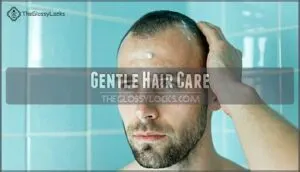This site is supported by our readers. We may earn a commission, at no cost to you, if you purchase through links.

Genetics play a big role, but you’re not powerless.
A balanced diet packed with protein, iron, and vitamins strengthens your hair from the inside out.
Be gentle—avoid harsh shampoos, aggressive brushing, and heat styling.
Stress can sneak up on you, so find ways to relax, whether it’s exercise or just some quiet time.
Treatments like minoxidil or finasteride can help if things get serious.
And don’t ignore early signs—catching it early gives you more options.
Think of your hair like a garden: care for it, and it’s more likely to thrive.
Table Of Contents
- Key Takeaways
- Hair Loss Causes
- Prevention Methods
- Treatment Options
- Risk Factors and Signs
- Managing Hair Loss
- Frequently Asked Questions (FAQs)
- How to prevent losing hair for men?
- What is the best preventative hair loss product for men?
- How does smoking impact hair loss progression?
- Are there any myths about wearing hats?
- Can certain hairstyles accelerate hair thinning?
- Does hair loss always require medical treatment?
- How do frequent styling products affect hair health?
- Conclusion
Key Takeaways
- Eat a balanced diet rich in protein, vitamins, and iron to strengthen your hair from within.
- Be gentle with your hair—use mild shampoos, avoid heat styling, and skip tight hairstyles that pull on your strands.
- Manage stress with relaxation techniques like exercise or mindfulness to protect your hair.
- Act early by exploring proven treatments like minoxidil or finasteride and consulting a dermatologist for personalized advice.
Hair Loss Causes
Hair loss happens for many reasons, but the main ones include genetics, health issues, certain medications, and lifestyle choices.
Hair loss stems from genetics, health, meds, and lifestyle—understanding these causes helps you take control and keep hair thriving.
Knowing what’s behind it can help you take the right steps to keep your hair healthier longer.
Genetic Factors
Blame your genes—male pattern baldness is hereditary. This genetic trait, officially called androgenetic alopecia, is influenced by predisposition genes passed through family history.
Inheritance patterns play a big role in hair loss genetics. Want clarity? Here’s a checklist:
- Check your family tree.
- Consider genetic testing.
- Learn about gene expression.
- Accept it—it’s not your fault!
Hair happens, or doesn’t, and understanding that it’s due to your genes and hereditary factors can help you cope with the issue.
Medical Conditions
Medical conditions like thyroid disorders and autoimmune diseases, such as alopecia areata, can lead to hair loss by attacking hair follicles or altering hormones.
Thyroid issues and autoimmune conditions, like alopecia areata, disrupt hair growth by targeting follicles or altering hormonal balance.
Scalp infections disrupt growth, while nutritional deficiencies like low iron (anemia) weaken strands.
Managing these hair loss causes in men often starts with treating the underlying issue, helping your hair—and confidence—bounce back.
Medications and Supplements
Finasteride and minoxidil are go-to options for slowing hair loss and regrowing hair.
DHT blockers prevent follicle shrinkage, while hair growth vitamins, like Viviscal, boost scalp health.
Minoxidil alternatives and supplements aim to support hair cycles naturally, and be cautious of prescription risks.
Emerging treatments, like baricitinib, show promise for severe cases, and always consult your doctor.
Lifestyle Factors
Building healthy habits is essential for your hair. A balanced diet fuels follicles, while regular exercise boosts circulation, feeding nutrients to your scalp.
Prioritize sleep quality—your hair loves rest too! Quit smoking and limit alcohol; they damage hair health.
Stress management matters since constant worry speeds up hair loss. Nicotine use can constrict blood vessels, impacting hair follicle health.
Early intervention and good nutrition keep strands strong and thriving, which is crucial for maintaining healthy habits.
Prevention Methods
Preventing hair loss starts with simple, effective habits you can control. Eating well, caring for your scalp, managing stress, and skipping harsh chemicals can make a real difference.
Healthy Diet and Nutrition
A healthy diet plays a key role in hair loss prevention.
Nutrient deficiencies can weaken hair, so focus on:
- Eating protein-rich foods like eggs and chicken for stronger strands.
- Getting hair growth vitamins, especially biotin and vitamin E.
- Including iron-packed greens for scalp health.
- Staying hydrated to maintain hair elasticity.
- Enjoying balanced meals to support long-term nutrition.
Consider incorporating omega-3 fatty acids to nourish hair follicles.
Gentle Hair Care
Using gentle hair care can make a big difference in hair loss prevention for men.
Wash with a mild hair loss shampoo, using lukewarm water to avoid damage. Skip harsh rubbing—pat dry with soft towels.
Wide combs prevent breakage, while avoiding heat styling protects hair strands. Protective styles and hair thickening products add volume without stress.
Consider using specialized shampoos for hair to help prevent further hair loss. Treat your hair kindly and use mild hair loss shampoo!
Reducing Stress
Stress can take a toll on your hair and self-confidence.
Tackle emotional challenges with simple actions:
- Practice mindfulness to quiet your mind.
- Try relaxation techniques, like deep breathing.
- Prioritize sleep quality—it’s essential for emotional health.
- Incorporate exercise for its stress-busting benefits.
- Take breaks to focus on hobbies you enjoy.
Small steps reduce stress, supporting hair and emotional well-being.
Avoiding Harsh Chemicals
To help with hair loss prevention, steer clear of hair care products packed with harsh chemical ingredients.
Look for natural shampoos and conditioners with sulfate alternatives. Safe styling is key—skip treatments that damage.
If you’re adventurous, try DIY products for gentler hair care. Protect your strands to keep them thriving, one gentle wash at a time, with a focus on gentler hair care.
Treatment Options
You’ve got plenty of options to tackle hair loss, from medicated solutions to surgical methods.
Finding the right treatment depends on your needs, so let’s break them down and make it simple.
Minoxidil and Prescription Medications
Building on proper hair care, treatments like minoxidil and prescription medications target male pattern baldness effectively.
Minoxidil boosts hair growth, while DHT blockers like finasteride reduce hormone-related thinning.
Here’s how these work:
- Minoxidil: Regrows hair, stops when discontinued.
- Prescription pills: Lower DHT, prevent loss.
- Combination therapy: Maximizes effectiveness.
Consider exploring options for minoxidil based products for hair regrowth.
Consult your doctor to tailor solutions!
Hair Transplants and Surgery
Hair transplant surgery offers a lasting fix for hair loss, using modern transplant techniques to move healthy follicles to thinning areas.
Graft survival rates depend on surgeon expertise and post-op care, while costs vary, and minor scarring concerns may arise.
Hair restoration provides natural results, making hair loss surgery a game-changer for regaining your confidence.
Laser Therapy and Low-Level Laser
Not all hair loss treatments are invasive. Low-level laser therapy (LLLT) is a safe, FDA-cleared option.
It stimulates hair growth and scalp health with minimal side-effects. LLLT devices enhance hair growth by targeting cytochrome c oxidase.
Try these approaches:
- Use at-home lasers like the Bosley Revitalizer.
- Combine with other treatments for better results.
- Stick to recommended schedules for effectiveness.
- Explore future research for innovative advancements.
Hairpieces and Wigs
A well-fitted wig or hairpiece can be a game-changer, offering instant coverage and confidence.
Wig material affects comfort and look, while proper wig styling and maintenance are essential for natural results.
Hairpiece cost varies, but options fit most budgets, and many men find quality hairpiece options to be a great solution.
Prioritize scalp health to avoid irritation, and explore hair systems as effective hair loss camouflage or replacement solutions.
Risk Factors and Signs
Hair loss can sneak up on you, but knowing what to watch for makes a big difference.
Understanding your risk factors, like genetics or age, helps you catch early signs before it’s too late.
Family History and Genetics
Male pattern baldness often runs in your family. Genetics play a big role, with androgenetic alopecia being the most common hereditary cause.
Spot these signs early by checking your family timeline. Baldness genes can trigger early onset in your 20s or 30s.
Watch for these genetic clues:
- Dad’s hairline.
- Mom’s side too!
- Gradual thinning.
- Crown patch expansion.
- Inheritance patterns repeat, which can be a clear indicator of male pattern baldness.
Age and Hormonal Changes
Your hairline might retreat as you age, thanks to DHT levels and androgen receptors playing tricks on testosterone’s impact.
Male pattern baldness, or androgenetic alopecia, often comes with shifting male hormones. Keep things steady by knowing the changes to expect.
Prevention includes early action, diet tweaks, and personalized hair loss prevention tips.
Here’s a quick comparison:
| Factor | Impact | Solution | Fun Fact |
|---|---|---|---|
| Aging Hairline | Thinning edges | Early consultation | Usually starts at temples |
| DHT Levels | Shrinks follicles | Medications help | Key cause of baldness |
| Testosterone Impact | Hair cycle disruption | Lifestyle changes | Menopause for women too |
| Androgen Receptors | Amplify DHT effects | Targeted treatment | Genes influence severity |
This information can help you understand the factors that contribute to hair loss and take preventive measures to maintain a healthy hairline.
Medical Conditions and Symptoms
Thinning hair isn’t always genetic—medical conditions play a huge role too.
Keep an eye out for:
- Thyroid Imbalance: It often triggers noticeable shedding.
- Autoimmune Diseases like Alopecia Areata, targeting hair follicles.
- Anemia Symptoms: Low iron levels impact hair growth.
- Scalp Infections: These inflame and disrupt follicles.
- DHT Sensitivity: A key cause of male pattern baldness.
Monitoring these helps pinpoint hair loss causes in men.
Early Warning Signs of Hair Loss
Noticing more strands on your pillow or brush? Excessive shedding could signal early hair loss.
Watch for a receding hairline, thinning crown, or unusual scalp changes. Patchy loss and sudden thinning might hint at male pattern baldness or other hair loss causes in men.
Catching these signs early helps you manage them effectively and explore solutions suited to your needs, which can help prevent further thinning.
Managing Hair Loss
You don’t have to face hair loss alone—managing it starts with understanding your options.
Taking care of your emotional well-being, building confidence, and staying healthy can make a world of difference.
Emotional Support and Counseling
Though hair loss can feel overwhelming, creating a support system makes a difference.
Try these ways to manage the emotional impact:
- Join hair loss support groups to share stories.
- Seek therapy to explore the emotional effects.
- Focus on self-esteem through positive affirmations.
- Discuss coping strategies with loved ones.
- Embrace community support for encouragement and understanding.
Stress can induce telogen effluvium, a common cause of hair shedding.
Building Self-Confidence and Acceptance
Confidence starts with positive self-talk—remind yourself that hair doesn’t define you.
Reframe your mindset by focusing on strengths, not flaws.
Build a support network of friends who uplift you.
Embrace body positivity and explore personal style, like bold fashion or a sharp shaved look.
Thriving with hair loss is possible when you embrace the emotional impact and lean into self-acceptance.
Maintaining Overall Health and Wellbeing
Keeping a healthy lifestyle boosts more than your confidence—it supports hair health too.
Regular physical activity improves blood flow, promoting scalp health. A balanced diet packed with vitamins and proteins strengthens hair from the inside out.
Stress management, like meditation or hobbies, can protect against hair loss. Remember, caring for yourself means better hair care and effective hair loss prevention.
Frequently Asked Questions (FAQs)
How to prevent losing hair for men?
Stick to a balanced diet, avoid smoking, and manage stress to keep your hair healthy.
Use gentle shampoos, try minoxidil, and consult a dermatologist early for personalized solutions.
Protect your scalp—skip tight hats and consider gentle approaches to hair care to maintain overall hair and scalp health.
What is the best preventative hair loss product for men?
Think of your scalp like a garden—minoxidil is your daily water and sunlight.
It’s FDA-approved, easy to use, and boosts hair growth.
Pair it with a healthy diet and gentle hair care habits.
How does smoking impact hair loss progression?
Smoking speeds up hair loss by damaging hair follicles and reducing blood flow to your scalp.
It also creates oxidative stress, which weakens hair strands.
Quitting isn’t just great for your lungs—it helps your hair too!
Are there any myths about wearing hats?
People often think wearing hats causes hair loss, but that’s just a myth.
Hats don’t affect your hair follicles.
Unless it’s too tight and rubs against your scalp, your favorite cap’s totally safe!
Can certain hairstyles accelerate hair thinning?
Tight hairstyles, like man buns or braids, tug at your scalp and can damage hair follicles over time.
This condition, traction alopecia, may lead to thin spots.
Looser styles help protect your hair’s health.
Does hair loss always require medical treatment?
Hair loss isn’t always a red flag needing medical attention.
Sometimes, it’s like autumn leaves falling—natural and temporary.
However, if it’s sudden or excessive, consulting a doctor helps uncover causes and guide treatment options.
How do frequent styling products affect hair health?
Using styling products too often can weaken your hair, especially if they contain harsh chemicals.
They can cause dryness, breakage, or buildup on the scalp.
Choose gentle, water-based products and avoid over-styling for healthier hair.
Conclusion
Think of your hair as a treasure—protect it, and it will reward you.
Hair loss prevention for men isn’t about magic; it’s about smart habits and early action.
Maintain a nutritious diet, avoid harsh treatments, and tackle stress head-on.
Keep an eye on changes, and don’t hesitate to explore treatments like minoxidil or finasteride if needed.
Remember, the earlier you act, the better your chances. Care for your hair daily—it’s worth the effort.














